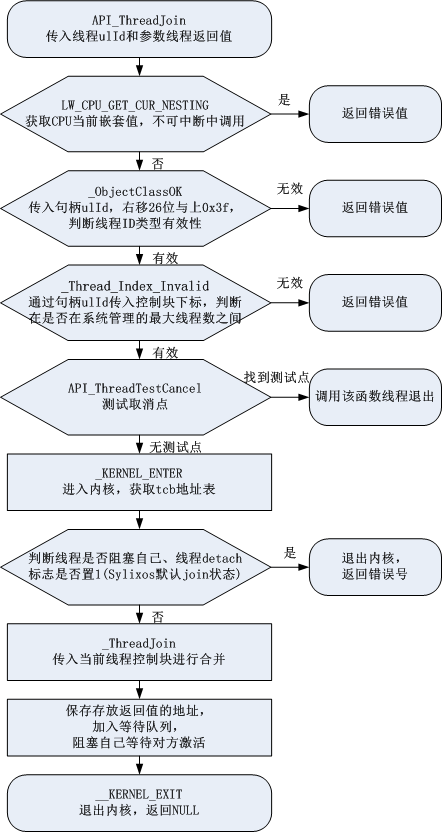1、开发环境
硬件平台:PC机
软件平台:Windows7,RealEvo-IDE
2、知识简介
2.1 概述
在创建线程实际上就是确定调用该线程函数的入口点,通常使用的函数是pthread_create()。在线程创建之后,就开始运行相关的线程函数,在该函数运行结束,线程也会随着退出。这是其中退出线程的一种方法,另外一种退出方法是调用pthread_exit()函数接口,这是结束函数的主动行为。pthread_exit()函数区别于exit()函数,调用exit()之后,所有该进程的线程都会被结束掉,因此,在线程中,利用pthread_exit()来替代进程中的exit()。
由于一个进程中的数据段是共享的,因此通常在线程退出之后,退出线程所占的资源并不会随着线程的结束而得到释放。正如进程之间可以调用wait()函数来同步并释放资源一样,线程之间也有类似的机制,那就是pthread_join()函数。pthread_join()可以将当前线程挂起,等待线程的结束,该函数是一个阻塞函数,调用它的函数将一直等待到被等待的线程结束为止,当函数返回时,被等待函数的资源会被释放。
一般情况下,线程在其主体函数退出的时候会自动退出,但同时也可以因为接收到另一个线程发来的取消请求而强制退出。
总结上述,单个线程可以通过3种方式退出:
-
线程可以简单地从线程入口函数中返回,返回值是线程的退出码;
-
线程可以被同一进程中的其他线程取消(详见《SylixOS中pthread_cancel函数浅析》);
-
线程显示地调用pthread_exit()函数。
SylixOS兼容绝大部分POSIX接口函数,因此可以直接调用以下函数:
2.2 pthread_join()函数简析
函数原型:
#include <pthread.h>
int pthread_join(pthread_t thread,void **ppstatus);
-
此函数成功返回0,失败返回错误号;
-
参数thread是需要join的线程句柄;
-
输出参数ppstatus是线程退出状态。
线程可以同步等待另一个线程退出,并获得其退出码。需要注意的是,同步等待的 目标线程必须处于合并状态,如图 2-1所示。

图 2-1线程同步等待
2.3 pthread_exit()函数简析
函数原型:
#include <pthread.h>
void pthread_exit(void * status);
-
此函数无返回值;
-
参数status是线程退出状态码。
线程结束即线程显示或者隐式地调用pthread_exit()函数,status通常表示一个整数,
以指向一个更复杂的数据结构体,线程结束码将被另一个与该线程进行了合并的线程得到。
2.4 pthread_cancel()函数简析
函数原型:
#include <pthread.h>
int pthread_cancel(pthread_t thread);
-
此函数成功返回0,失败返回错误号;
-
参数thread是取消的线程句柄。
pthread_cancel()函数和目标线程的取消动作是异步的,根据目标线程的设置不同,取消请求可能被忽略、立即执行或延迟处理。
3、 技术实现
3.1 pthread_join()函数实现
SylixOS中pthread_join()函数实现机制,如图 3-1所示:

图 3-1 pthread_join()函数实现流程
代码中如果没有pthread_join(),主线程会很快结束从而使整个进程结束,从而使创建的线程没有机会开始执行就结束了。加入pthread_join()后,主线程会一直等待直到等待的线程结束自己才结束,使创建的线程有机会执行。所有线程都有一个线程号,也就是thread id,其类型为pthread_t,通过调用pthread_self()函数可以获得自身的线程号。
示例代码如图 3-2所示:
#include <stdio.h>
#include <pthread.h>
void *routine (void *arg)
{
fprintf(stdout, "thread 1 return.\n");
return ((void *)1);
}
void *routine1 (void *arg)
{
fprintf(stdout, "thread 2 exit.\n");
return ((void *)2);
}
int main (int argc, char **argv)
{
pthread_t tid, tid1;
int iRet;
void *retval;
/* 创建routine线程*/
iRet = pthread_create(&tid, NULL, routine, NULL);
if (iRet != 0) {
fprintf(stderr, "pthread create failed.\n");
return (-1);
}
/* 线程等待合并 */
iRet = pthread_join(tid, &retval);
if (iRet != 0) {
fprintf(stderr, "pthread join thread 1 failed.\n");
return (-1);
}
fprintf(stdout, "thread 1 return code: %ld\n", (long)retval);
/* 创建routine1线程*/
iRet = pthread_create(&tid1, NULL, routine1, NULL);
if (iRet != 0) {
fprintf(stderr, "pthread create failed.\n");
return (-1);
}
/* 线程等待合并 */
iRet = pthread_join(tid1, &retval);
if (iRet != 0) {
fprintf(stderr, "pthread join thread 2 failed.\n");
return (-1);
}
fprintf(stdout, "thread 2 exit code: %ld\n", (long)retval);
return (0);
}
图 3-2 pthread_join()函数示例
在SylixOS的shell下运行程序,结果如下:
# ./join_test
thread 1 return.
thread 1 return code: 1
thread 2 exit.
thread 2 exit code: 2
3.2 pthread_exit()函数实现
用pthread_exit()来调用线程的返回值,用来退出线程,但是退出线程所占资源不会随便线程的终止而释放资源。
pthread_exit()调用线程的返回值,可由其他函数如pthread_join()来检索获取。
示例代码如图 3-3所示:
#include <stdio.h>
#include <pthread.h>
void thread_1 (void)
{
int i = 0;
for(i = 0; i <=6; i++){
printf("This is a pthread_1.\n");
if(i == 2){
pthread_exit(0); /* 显示调用pthread_exit */
}
sleep(1);
}
}
void thread_2 (void)
{
int i;
for(i = 0; i<3; i++){
//printf("This is a pthread_2.\n");
;
}
pthread_exit(0); /* 显示调用pthread_exit */
}
int main (int argc, char **argv)
{
pthread_t id_1,id_2;
int iRet ;
/* 创建线程1 */
iRet = pthread_create(&id_1, NULL, (void *)thread_1, NULL);
if(iRet != 0){
printf("Create pthread_1 error\n");
return -1;
}
/* 创建线程1 */
iRet = pthread_create(&id_2, NULL, (void *)thread_2, NULL);
if(iRet != 0){
printf("Create pthread_2 error\n");
return -1;
}
pthread_join(id_1, NULL); /* 等待线程结束 */
pthread_join(id_2, NULL);
return (0);
}
图 3-3 pthread_exit()函数示例
在SylixOS的shell下运行程序,结果如下:
# ./pthread_exit
This is a pthread_1.
This is a pthread_2.
This is a pthread_2.
This is a pthread_2.
This is a pthread_1.
This is a pthread_1.





















 177
177











 被折叠的 条评论
为什么被折叠?
被折叠的 条评论
为什么被折叠?








